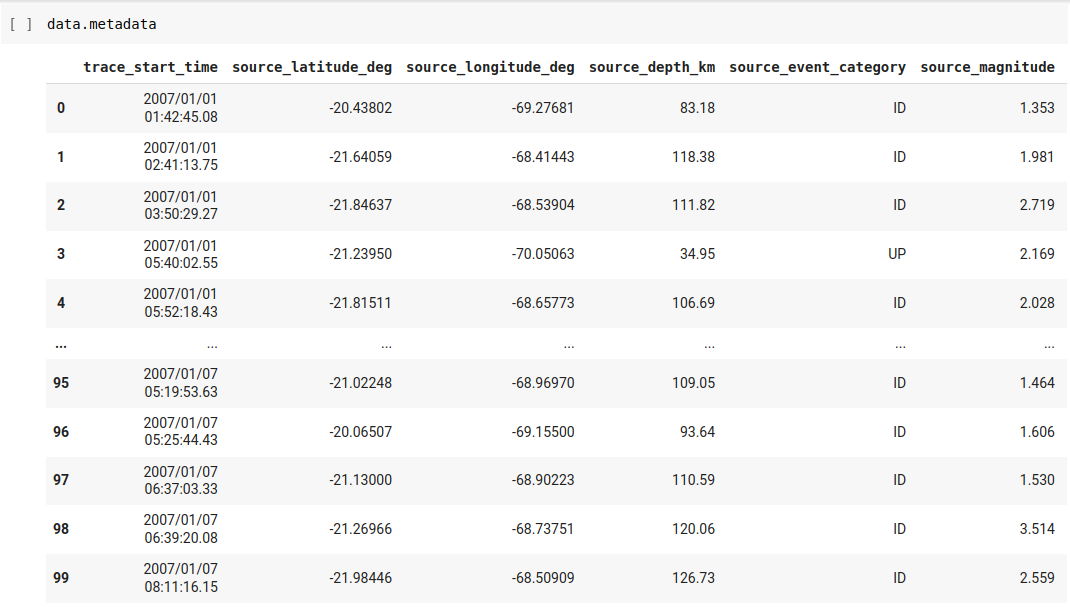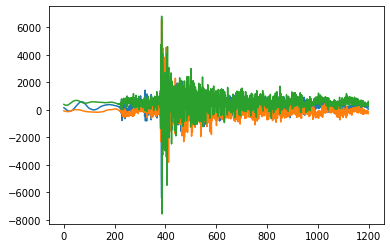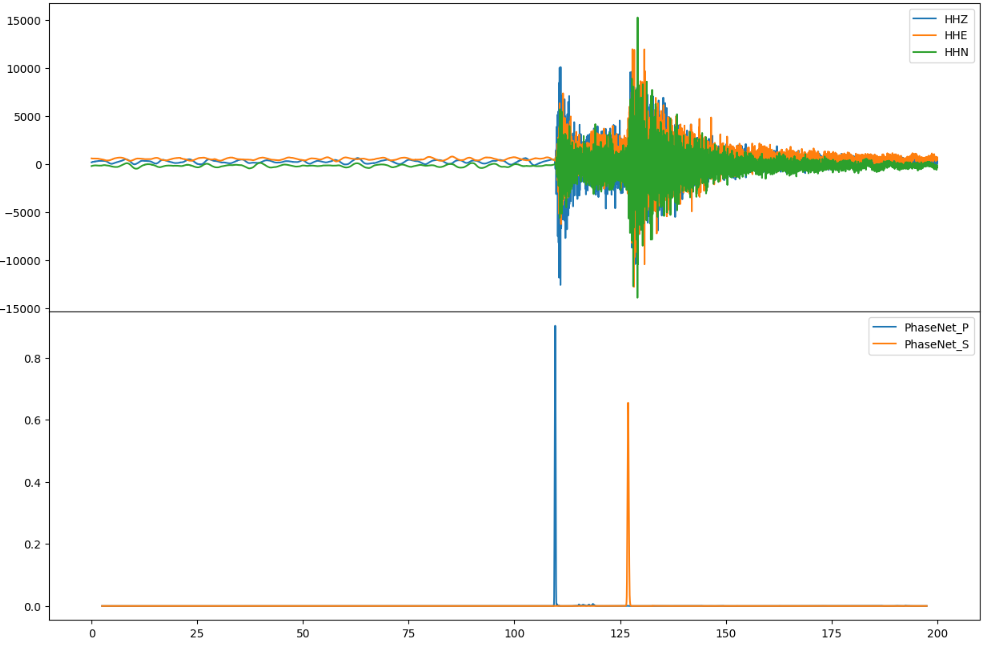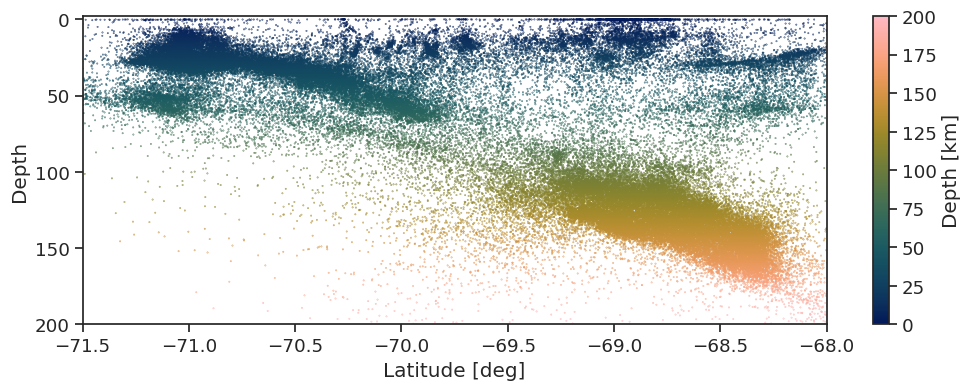SeisBench: A toolbox for machine learning in seismology
SeisBench is an open-source Python toolbox for machine learning in seismology. It brings together the whole machine learning model lifecycle: datasets and benchmarks, models and training pipelines, and efficient implementations for deploying the models in production.
Cite this software
Description
The Seismology Benchmark collection (SeisBench) is an open-source python toolbox for
machine learning in seismology. It provides a unified API for accessing seismic datasets and both training and applying machine learning algorithms to seismic data. SeisBench has been built to reduce the overhead when applying or developing machine learning techniques for seismological tasks.
To get started, try one of our example notebooks. For more detailed information on SeisBench check out the SeisBench documentation
Usage examples
Managing datasets and benchmark data
The SeisBench data module provides everything around data management.
This includes a common data format, tools to compile datasets in this format, and pre-compiled benchmark datasets that are hosted in the SeisBench repository.
Each dataset consists of two parts, the metadata and associated seismic waveforms. Waveforms are modeled as dataframes and are flexible in terms of their columns. Here is an example metadata for a dataset.

To each row in the metadata, there is an associated waveform. Here is an example three-component waveform trace.

Internally, waveforms are stored in hdf5-files. This allows managing large quantities of data while at the same time achieving high throughput rates for the training of deep learning models.
For further details, check the dataset basics notebook or the creating a dataset notebook
.
Training ML models
The SeisBench model module contains a wide variety of deep learning models for processing seismic waveforms, for example, for event detection, phase picking, denoising and depth estimation.
To efficiently train these models, SeisBench offers custom, modular training pipelines with the generate module.
These convert the data from the datasets into the input format for each model, provide the correct label format and can also facilitate data augmentation.
Here's an example of a simple generator pipeline.

For more details, check out the notebook on generator pipelines . To learn how to train a deep learning model from scratch using SeisBench datasets and generator pipelines, try the training phasenet notebook
.
Deploying ML models
SeisBench bridges the gap between deep learning developers and seismological practitioners by allowing easy deployment of SeisBench models. To this end, SeisBench comes with a large collection of pretrained models and with a unified interface for all models. This interface allows to directly apply the models to all common data formats of seismic data. Here is an example showing the waveforms of an earthquake in Chile together with the predictions from PhaseNet implemented in SeisBench.

This example notebook provides details on how to deploy trained SeisBench models.
SeisBench can also be integrated into larger event detection pipelines. The notebook on creating a seismicity catalog walks users through the steps of phase picking and association on the challenging 2014 Iquique earthquake sequence in Northern Chile. This workflow allows to compile highly complete earthquake catalogs as visualised below.

References
-
Woollam, J., Münchmeyer, J., Tilmann, F., Rietbrock, A., Lange, D., Bornstein, T., ... & Soto, H. (2022). SeisBench—A toolbox for machine learning in seismology. Seismological Research Letters, 93(3), 1695-1709. https://doi.org/10.1785/0220210324
Reference publication for software.
-
Münchmeyer, J., Woollam, J., Rietbrock, A., Tilmann, F., Lange, D., Bornstein, T., ... & Soto, H. (2022). Which picker fits my data? A quantitative evaluation of deep learning based seismic pickers. Journal of Geophysical Research: Solid Earth, 127(1), e2021JB023499.
https://doi.org/10.1029/2021JB023499Example of in-depth bencharking study of deep learning-based picking routines using the SeisBench framework.
Acknowledgement
The initial version of SeisBench has been developed at GFZ Potsdam and KIT with funding from Helmholtz AI. The SeisBench repository is hosted by HIFIS - Helmholtz Federated IT Services.

- GPL-3.0-only
Participating organisations
Reference papers
- 1.Author(s): Jack Woollam, Jannes Münchmeyer, Frederik Tilmann, Andreas Rietbrock, Dietrich Lange, Thomas Bornstein, Tobias Diehl, Carlo Giunchi, Florian Haslinger, Dario Jozinović, Alberto Michelini, Joachim Saul, Hugo SotoPublished in Seismological Research Letters by Seismological Society of America (SSA) in 2022, page: 1695-170910.1785/0220210324
- 2.Author(s): Jannes Münchmeyer, Jack Woollam, Andreas Rietbrock, Frederik Tilmann, Dietrich Lange, Thomas Bornstein, Tobias Diehl, Carlo Giunchi, Florian Haslinger, Dario Jozinović, Alberto Michelini, Joachim Saul, Hugo SotoPublished in Journal of Geophysical Research: Solid Earth by American Geophysical Union (AGU) in 202210.1029/2021jb023499
Mentions
- 1.Author(s): Ari Fadli, Tri Kuntoro Priyambodo, Agfianto Eko Putra, Wiwit SuryantoPublished in Advances in Science, Technology & Innovation, Geographic Approaches to Climate Change and Mitigation: Urban and Rural Perspectives (Volume 1) by Springer Nature Switzerland in 2025, page: 137-14810.1007/978-3-031-92119-3_13
- 2.Author(s): Yapei Ye, Renqi LuPublished in Scientific Investigation of Continental Earthquakes and Relevant Studies by Springer Nature Singapore in 2025, page: 47-6510.1007/978-981-96-2826-1_4
- 3.Author(s): Samuel Myren, Nidhi Parikh, Garrison Flynn, Dave Higdon, Emily CasletonPublished in Data Science in Engineering Vol. 10 by River Publishers in 2025, page: 7-1810.1007/978-3-031-68142-4_2
- 4.Author(s): Yu Wang, Junhao Qu, Yuyan Shi, Shaohui Zhou, Tingting ChenPublished in Advances in Transdisciplinary Engineering, Applied Mathematics, Modeling and Computer Simulation by IOS Press in 202310.3233/atde230975
- 1.Author(s): Oliver D. LambPublished in 2024 International Conference on Machine Intelligence for GeoAnalytics and Remote Sensing (MIGARS) by IEEE in 2024, page: 1-310.1109/migars61408.2024.10544631
- 2.Author(s): Kun'ao Zhu, Yongming Huang, Jun Chen, Yejun SunPublished in 2023 3rd International Conference on Computer Science, Electronic Information Engineering and Intelligent Control Technology (CEI) by IEEE in 2023, page: 469-47210.1109/cei60616.2023.10528053
- 1.Author(s): Leda Sánchez Bettucci, Martín Rodríguez Kacevas, Hernan Castro, Judith Loureiro Olivet, Enrique LatorresPublished in Journal of South American Earth Sciences by Elsevier BV in 2025, page: 10557810.1016/j.jsames.2025.105578
- 2.Author(s): Jannes Münchmeyer, Diego Molina‐Ormazabal, Mathilde Radiguet, David Marsan, Juan‐Carlos Baez, Francisco Ortega‐Culaciati, Andres Tassara, Marcos Moreno, Anne SocquetPublished in Geophysical Research Letters by American Geophysical Union (AGU) in 202510.1029/2024gl113953
- 3.Author(s): Samuel Myren, Nidhi Parikh, Rosalyn Rael, Garrison Flynn, Dave Higdon, Emily CasletonPublished in Seismological Research Letters by Seismological Society of America (SSA) in 2025, page: 471-48610.1785/0220240444
- 4.Author(s): Chenglong Duan, Brandon Schmandt, Ross Maguire, Ruijia Wang, Qingkai KongPublished in The Seismic Record by Seismological Society of America (SSA) in 2025, page: 218-22710.1785/0320250015
- 5.Author(s): Yongsoo Park, Gregory C. BerozaPublished in The Seismic Record by Seismological Society of America (SSA) in 2025, page: 55-6310.1785/0320240028
- 6.Author(s): Min Liu, Yen Joe TanPublished in Geophysical Journal International by Oxford University Press (OUP) in 202510.1093/gji/ggaf256
- 7.Author(s): Rintaroh Suzuki, Naoki Uchida, Weiqiang Zhu, Gregory C. Beroza, Takashi Nakayama, Keisuke Yoshida, Genti Toyokuni, Ryota Takagi, Ryosuke Azuma, Akira HasegawaPublished in Science by American Association for the Advancement of Science (AAAS) in 2025, page: 190-19410.1126/science.adt6389
- 8.Author(s): Jongwon Han, Seongryong Kim, Dong-Hoon SheenPublished in Seismological Research Letters by Seismological Society of America (SSA) in 2025, page: 2405-241710.1785/0220240384
- 9.Author(s): Jannes Münchmeyer, William B. Frank, Sophie Giffard‐Roisin, David Marsan, Frederik Tilmann, Marcos Moreno, Anne SocquetPublished in Journal of Geophysical Research: Solid Earth by American Geophysical Union (AGU) in 202510.1029/2025jb031283
- 10.Author(s): Sebastián Núñez-Jara, Patricia Martínez-Garzón, Grzegorz Kwiatek, Yehuda Ben-Zion, Georg Dresen, Dirk Becker, Fabrice Cotton, Marco BohnhoffPublished in Earth and Planetary Science Letters by Elsevier BV in 2025, page: 11957010.1016/j.epsl.2025.119570
- 11.Author(s): Lydie Gailler, Clément Grace, Guillaume Boudoire, Marc Grunberg, Jean Battaglia, Charley Merciecca, Philippe Labazuy, Thierry Souriot, Jean-Michel Douchain, Nicolas Cluzel, Romain Guillard, Valentin Fréret Lorgeril, Cyril Aumar, Victoria Rafflin, Vincent Boulenger, Solène Buvat, Jehoji Kuzamba, Erwan ThébaultPublished in Comptes Rendus. Géoscience by Cellule MathDoc/Centre Mersenne in 2025, page: 61-7810.5802/crgeos.284
- 12.Author(s): Ling Peng, Lei Li, S. Mostafa Mousavi, Xiaobao Zeng, Gregory C. BerozaPublished in Computers & Geosciences by Elsevier BV in 2025, page: 10599110.1016/j.cageo.2025.105991
- 13.Author(s): Wei-Fang Sun, Sheng-Yan Pan, Yao-Hung Liu, Hao Kuo-Chen, Chin-Shang Ku, Che-Min Lin, Ching-Chou FuPublished in Sensors by MDPI AG in 2025, page: 335310.3390/s25113353
- 14.Author(s): Yingchen Liu, Dietrich Lange, Ingo GrevemeyerPublished in Journal of Geophysical Research: Solid Earth by American Geophysical Union (AGU) in 202510.1029/2024jb030845
- 15.Author(s): Jean Baptiste Tary, Sergio F. Poveda, Ka Lok Li, Christine Peirce, Richard W. Hobbs, Carlos Alberto VargasPublished in The Journal of the Acoustical Society of America by Acoustical Society of America (ASA) in 2025, page: 1386-139710.1121/10.0039043
- 16.Author(s): Pieter-Ewald Share, Anne M. Tréhu, Armin Stuedlein, Hannah R. Reinhard, Aurélien Mordret, Rachel A. M. WayPublished in Seismological Research Letters by Seismological Society of America (SSA) in 202510.1785/0220250098
- 17.Author(s): Rossella Fonzetti, Aladino Govoni, Pasquale De Gori, Luisa Valoroso, Claudio ChiarabbaPublished in Geophysical Journal International by Oxford University Press (OUP) in 202510.1093/gji/ggaf286
- 18.Author(s): Roberto Cabieces, Thiago C. Junqueira, Katrina Harris, Jesús Relinque, Claudio Satriano, Jiri VackářPublished in Seismological Research Letters by Seismological Society of America (SSA) in 2025, page: 3231-324310.1785/0220240186
- 19.Author(s): Marie Baillet, Diane Rivet, Alister Trabattoni, Jérôme Cheze, Fabrice Peix, David Ambrois, Martijn van den Ende, Clara Vernet, Claudio Strumia, Bertrand Potin, Rodrigo Sanchez, Sergio BarrientosPublished in Journal of Geophysical Research: Solid Earth by American Geophysical Union (AGU) in 202510.1029/2025jb031565
- 20.Author(s): Benedikt Braszus, Andreas Rietbrock, Christian HaberlandPublished in Journal of Geophysical Research: Solid Earth by American Geophysical Union (AGU) in 202510.1029/2025jb031877
- 21.Author(s): Louis Quinones, Rigobert TibiPublished in Seismological Research Letters by Seismological Society of America (SSA) in 2025, page: 173-18610.1785/0220250053
- 22.Author(s): Utku Ünal, Tolga Bekler, Feyza Nur BeklerPublished in Türk Deprem Araştırma Dergisi by Turkish Journal of Earthquake Research, Disaster and Emergency Management Authority in 2025, page: 90-10010.46464/tdad.1597618
- 23.Author(s): Ekrem Zor, Zhigang Peng, Mehmet Ergin, Eric Sandvol, Fatih Sevim, Mustafa Cengiz Tapırdamaz, Phuc Mach, Oğuzhan Yalvaç, Adil Tarancıoğlu, Mustafa Kemal Koşma, Oluwaseyifunmi Adeboboye, Chang Ding, Cem Açıkgöz, Ersin BüyükPublished in Seismological Research Letters by Seismological Society of America (SSA) in 2025, page: 2683-269710.1785/0220240152
- 24.Author(s): Mohammadreza Jamalreyhani, Ruijia Wang, Brandon Schmandt, Andres Felipe Peña Castro, Margaret Elizabeth GlasgowPublished in Geophysical Research Letters by American Geophysical Union (AGU) in 202510.1029/2025gl114675
- 25.Author(s): Peter Niemz, Kris Pankow, Marius P. Isken, Katherine Whidden, John McLennan, Joe MoorePublished in Seismological Research Letters by Seismological Society of America (SSA) in 2025, page: 1603-161810.1785/0220240300
- 26.Author(s): Marius Isken, Sebastian Heimann, Peter Niemz, Jannes Münchmeyer, Simone Cesca, Hannes Vasyura-Bathke, Torsten DahmPublished in Seismica by McGill University Library and Archives in 202510.26443/seismica.v4i1.1283
- 27.Author(s): Marcell Pásztor, Tereza Sindelarova, Daniela Ghica, Ulrike Mitterbauer, Oleksandr Liashchuk, Giorgio Lacanna, Maurizio Ripepe, István BondárPublished in Journal of Geophysical Research: Atmospheres by American Geophysical Union (AGU) in 202510.1029/2025jd044047
- 28.Author(s): Yijian Zhou, Hongyang Ding, Abhijit Ghosh, Zengxi GePublished in Journal of Geophysical Research: Solid Earth by American Geophysical Union (AGU) in 202510.1029/2025jb031294
- 29.Author(s): Yongsoo Park, Alysha D Armstrong, William L Yeck, David R Shelly, Gregory C BerozaPublished in Geophysical Journal International by Oxford University Press (OUP) in 202510.1093/gji/ggaf333
- 30.Author(s): D. Pragnath, G. Srijayanthi, Santosh Kumar, Sumer ChopraPublished in Applied Computing and Geosciences by Elsevier BV in 2025, page: 10023210.1016/j.acags.2025.100232
- 31.Author(s): Aming Wu, Irshad Khan, Young-Woo KwonPublished in Scientific Reports by Springer Science and Business Media LLC in 202510.1038/s41598-024-82087-2
- 32.Author(s): Ling Peng, Lei Li, Xiaobao ZengPublished in Applied Sciences by MDPI AG in 2025, page: 342410.3390/app15073424
- 33.Author(s): Janis Heuel, Vincent Maurer, Michael Frietsch, Andreas RietbrockPublished in Seismica by McGill University Library and Archives in 202510.26443/seismica.v4i2.1579
- 34.Author(s): Zamir Khurshid, Hamzeh Mohammadigheymasi, Dawei Gao, Jianxin Liu, S. Mostafa Mousavi, Zhenwei Guo, Nasrin TavakolizadehPublished in Seismological Research Letters by Seismological Society of America (SSA) in 2025, page: 2225-224010.1785/0220240307
- 35.Author(s): Anup K. Sutar, Sunil Rohilla, Himanshu Chaube, Charulata ChaudhariPublished in Tectonophysics by Elsevier BV in 2025, page: 23074310.1016/j.tecto.2025.230743
- 36.Author(s): Evi Pappa, Costas Papazachos, Nikos Chatzis, Ioannis Grendas, Nikos Theodoulidis, Petros TriantafyllidisPublished in Bulletin of the Seismological Society of America by Seismological Society of America (SSA) in 2025, page: 1739-176010.1785/0120240201
- 37.Author(s): Sarah K. Noel, Michael E. WestPublished in Bulletin of the Seismological Society of America by Seismological Society of America (SSA) in 2025, page: 2096-210810.1785/0120250021
- 38.Author(s): Giacomo Mastella, Giulio Poggiali, Federico Pignalberi, Marco ScuderiPublished in Seismological Research Letters by Seismological Society of America (SSA) in 202510.1785/0220250025
- 39.Author(s): Makoto Naoi, Shiro Hirano, Youqing ChenPublished in Progress in Earth and Planetary Science by Springer Science and Business Media LLC in 202510.1186/s40645-025-00696-5
- 40.Author(s): Albert Leonardo Aguilar Suarez, Gregory BerozaPublished in Seismica by McGill University Library and Archives in 202510.26443/seismica.v4i1.1431
- 41.Author(s): Qibin Shi, Marine A. Denolle, Yiyu Ni, Ethan F. Williams, Nan YouPublished in Journal of Geophysical Research: Solid Earth by American Geophysical Union (AGU) in 202510.1029/2024jb029728
- 42.Author(s): R. Lescoutre, J.-B. Ammirati, S. Chevrot, F. Mouthereau, M. Ducoux, N. Saspiturry, A. Villaseñor, M. Sylvander, E. MasiniPublished in Tectonophysics by Elsevier BV in 2025, page: 23068510.1016/j.tecto.2025.230685
- 43.Author(s): Chengping Chai, Derek Rose, Scott Stewart, Nathan Martindale, Mark Adams, Lisa Linville, Christopher Stanley, Anibely Torres Polanco, Philip BinghamPublished in Seismological Research Letters by Seismological Society of America (SSA) in 2025, page: 2394-240410.1785/0220240353
- 44.Author(s): Macarena Garay, Millaray Curilem, Jonathan Lazo, Fernando Huenupan, Daniel BasualtoPublished in Journal of Volcanology and Geothermal Research by Elsevier BV in 2025, page: 10835010.1016/j.jvolgeores.2025.108350
- 45.Author(s): A. Warwel, D. Lange, A. Dannowski, E. Contreras‐Reyes, I. Klaucke, J. Diaz‐Naveas, M. Moreno, H. KoppPublished in Geochemistry, Geophysics, Geosystems by American Geophysical Union (AGU) in 202510.1029/2024gc011829
- 46.Author(s): Jannes Münchmeyer, Diego Molina‐Ormazabal, David Marsan, Mickaël Langlais, Juan‐Carlos Baez, Ben Heit, Diego González‐Vidal, Marcos Moreno, Frederik Tilmann, Dietrich Lange, Anne SocquetPublished in Journal of Geophysical Research: Solid Earth by American Geophysical Union (AGU) in 202510.1029/2025jb031256
- 47.Author(s): Feiyi Wang, Xuezhen Zhang, Xiaodong SongPublished in Seismological Research Letters by Seismological Society of America (SSA) in 202510.1785/0220240437
- 48.Author(s): Diego Molina‐Ormazabal, Mathilde Radiguet, Jannes Münchmeyer, Nicolas Hernandez‐Soto, Adrien Vezinet, Lea Pousse‐Beltran, Catalina Castro, Marie‐Pierre Doin, Juan Carlos Baez, Marcos Moreno, Andres Tassara, Philippe Durand, Anne SocquetPublished in Journal of Geophysical Research: Solid Earth by American Geophysical Union (AGU) in 202510.1029/2024jb030796
- 49.Author(s): Shinya Katoh, Yoshihisa Iio, Hiromichi Nagao, Hiroshi Katao, Masayo Sawada, Kazuhide TomisakaPublished in Earth, Planets and Space by Springer Science and Business Media LLC in 202510.1186/s40623-025-02249-y
- 50.Author(s): Joses Omojola, Patricia PersaudPublished in Seismological Research Letters by Seismological Society of America (SSA) in 202510.1785/0220250124
- 1.Author(s): Marco Esposito, Alberto Belli, Laura Falaschetti, Lorenzo Palma, Paola PierleoniPublished in 202510.1109/jiot.2025.3527750
- 2.Author(s): Alexander Wickham‐Piotrowski, Anne Meltzer, Gabriela Ponce, Steven Roecker, Susan Beck, Mario Ruiz, Stephen Hernandez, Monica SegoviaPublished in 202510.1029/2025jb031212
- 3.Author(s): Shuai Lv, Yuxiang PengPublished by Elsevier BV in 202510.2139/ssrn.5492786
- 4.Author(s): Yuqi Cai, Ziye Yu, Xin Liu, Yanru An, Yunpeng Zhang, Lu Li, Yingying Zhang, Xiaona MaPublished in 202510.1029/2025jh000944
- 5.Author(s): Leda Sanchez Bettucci, Martín Rodríguez Kacevas, Hernán Castro, Judith Loureiro Olivet, Enrique LatorresPublished by Elsevier BV in 202510.2139/ssrn.5139017
- 6.Author(s): Viesturs Zandersons, Jānis KarušsPublished in 202510.1016/j.tecto.2025.231012
- 7.Author(s): Kevin A. Vargas-Zamudio, Mathieu Perton, Denis Legrand, Francisco J. Sánchez-SesmaPublished by Springer Science and Business Media LLC in 202510.21203/rs.3.rs-6999643/v1
- 8.Author(s): Li-yuan Ou, Lin-qi Huang, Yun-ge Zhao, Zhao-wei Wang, Hui-ming Shen, Xi-bing LiPublished in 202510.1007/s11771-025-6077-1
- 9.Author(s): Yasunori Sawaki, Takahiro Shiina, Takahiko UchidePublished by Springer Science and Business Media LLC in 202510.21203/rs.3.rs-6353744/v1
- 10.Author(s): Kevin A. Vargas-Zamudio, Mathieu Perton, Denis Legrand, Francisco J. Sánchez-SesmaPublished in 202510.1007/s12145-025-02062-x
- 11.Author(s): Chengping Chai, Derek Rose, Scott Stewart, Nathan Martindale, Mark Adams, Anibely Torres Polanco, Lisa Linville, Christopher Stanley, Philip BinghamPublished in 202510.1785/0120250143
- 12.Author(s): Jim Bradford, Eric Kiser, Susan Beck, Martin Fernandez, Ryan Porter, Sebastian Tauber, Ariane Maharaj, Mauro SaezPublished in 202510.21203/rs.3.rs-8060109/v1
- 13.Author(s): Makoto Naoi, Kengo Shimojo, Koji TamaribuchiPublished in 202510.21203/rs.3.rs-8174647/v1
- 14.Author(s): José Morales, Miguel Ángel Dengra, José Ángel López-Comino, Pedro Jesús López-Abenza, Daniel Stich, Carlos Araque-Pérez, Simone Cesca, Jorge MaestrePublished in 202510.1093/gji/ggaf132
- 15.Author(s): Joe Carthy, Pablo Rey-Devesa, Manuel Titos, Carmen BenitezPublished in 202510.1109/jstars.2025.3559412
- 16.Author(s): Bingyao Han, Li Ma, Hua Kong, Zhuowei XiaoPublished in 202510.3390/s25237238
- 17.Author(s): Kuan-Wei Tang, Kuan-Yu ChenPublished in 202510.1016/j.cageo.2025.106080
- 18.Author(s): Yunfei Zhou, Haoran Ren, Haofeng WuPublished in 202510.1109/lgrs.2025.3603915
- 19.Author(s): Yun Zhang, Xihai Li, Xiaoniu Zeng, Jihao Liu, Chaoying BaiPublished in 202510.1093/gji/ggaf303
- 20.Author(s): Yasunori Sawaki, Takahiro Shiina, Takahiko Uchide, Yasunori Sawaki, Takahiro Shiina, Takahiko UchidePublished in 202510.1186/s40623-025-02311-9
- 21.Author(s): Jan-Phillip Föst, Joachim R.R. Ritter, Christos P. Evangelidis, Efthimios Sokos, Nicole Richter, Klaus R. ReicherterPublished in 202510.4401/ag-9155
- 22.Author(s): Mohammad Raeesi, Aram Fathian, Ali Misaghi, Cristiano TolomeiPublished in 202510.1016/j.pepi.2025.107467
- 23.Author(s): Yuriko Iwasaki, Susan Y. Schwartz, Kimihiro Mochizuki, Heather Crume, Dan Bassett, Tomoaki Yamada, Doron Morad, Yuriko Iwasaki, Susan Y. Schwartz, Kimihiro Mochizuki, Heather Crume, Dan Bassett, Tomoaki Yamada, Doron MoradPublished in 202510.1029/2025jb031751
- 24.Author(s): Arthur Cuvier, Julie Maury, Hideo Aochi, Hugo BreuillardPublished in 202510.1785/0220250210
- 25.Author(s): Filippos Vallianatos, Vasilis Kapetanidis, Georgios Michas, Andreas KarakonstantisPublished in 202510.1016/j.tecto.2025.231045
- 26.Author(s): Patrick Schäfer, Jakob Brand, Ulf Leser, Botao Peng, Themis PalpanasPublished in 202510.1109/icde65448.2025.00186
- 27.Author(s): Yiyu Ni, Marine A Denolle, Jannes Münchmeyer, Yinzhi Wang, Kuan-Fu Feng, Carlos Garcia Jurado Suarez, Amanda M Thomas, Chad Trabant, Alex Hamilton, David MencinPublished in 202510.1093/gji/ggaf322
- 28.Author(s): Yazhuo Wang, Youyi RuanPublished in 202510.1109/tgrs.2025.3555661
- 29.Author(s): Weitao Wang, Zemin Liu, Ziye YuPublished in 202510.1093/gji/ggaf292
- 30.Author(s): Kadek Hendrawan Palgunadi, Andreas Bergmeister, Andrea Bosisio, Laura A. Ermert, Maria Koroni, Nathanaël Perraudin, Simon Dirmeier, Men‐Andrin MeierPublished in 202510.1029/2025jh000862
- 31.Author(s): Tomoki Tokuda, Hiromichi NagaoPublished in 202510.1093/gji/ggaf400
- 32.Author(s): Mitsuyuki OzawaPublished in 202510.3124/segj.78.sp47
- 33.Author(s): Hsiang‐Yu Yang, Hsin‐Hua Huang, Hsi‐An Chen, Cheng‐Nan Liu, Yu‐Fang Hsu, Wen‐Tzong Liang, Chin‐Shang KuPublished in 202510.1029/2025jb032792
- 34.Author(s): Xu Si, Xinming Wu, Hanlin Sheng, Jun Zhu, Zefeng LiPublished in 202410.1109/tgrs.2024.3354456
- 35.Author(s): Shuguang Zhao, Yadongyang ZhuPublished in 202410.1109/accis62068.2024.10948658
- 36.Author(s): Hanyang Li, Jiahui Li, Xuegui Li, Hongli DongPublished in 202410.1109/tgrs.2024.3476329
- 37.Author(s): Jiarun Zhou, Thanh-Son Pham, Hrvoje TkalčićPublished by Wiley in 202410.22541/essoar.171378807.79679078/v1
- 38.Author(s): Long Minh Ho, Jacob I. Walter, Samantha E Hansen, José Luis Sánchez-Roldán, Zhigang PengPublished by Wiley in 202410.22541/essoar.171033153.33947266/v1
- 39.Author(s): Cindy S Y Lim, Sacha Lapins, Margarita Segou, Maximilian J WernerPublished by Wiley in 202410.22541/essoar.170914509.92208553/v1
- 40.Author(s): Yiyuan Zhong, Yen Joe TanPublished by Wiley in 202410.22541/essoar.170688948.84814640/v2
- 41.Author(s): Cindy S Y Lim, Sacha Lapins, Margarita Segou, Maximilian J WernerPublished in 202410.1093/gji/ggae386
- 42.Author(s): Makoto Naoi, Koji Tamaribuchi, Kengo Shimojo, Shinya Katoh, Shukei OhyanagiPublished by Springer Science and Business Media LLC in 202410.21203/rs.3.rs-4464239/v1
- 43.Author(s): Hanyang Li, Xuegui Li, Yuhang Sun, Hongli Dong, Gang XuPublished in 202410.1109/tgrs.2024.3462935
- 44.Author(s): Francesco Scotto di Uccio, Maddalena Michele, Claudio Strumia, Mariano Supino, Gregory C. Beroza, Lauro Chiaraluce, Nicola D'Agostino, Gaetano FestaPublished by Wiley in 202410.22541/au.170534717.72001236/v1
- 45.Author(s): Qibin Shi, Marine A Denolle, Yiyu Ni, Ethan F Williams, Nan YouPublished by Wiley in 202410.22541/essoar.172252976.63050899/v1
- 46.Author(s): Shinya Katoh, Yoshihisa Iio, Hiromichi Nagao, Hiroshi Katao, Masayo Sawada, Kazuhide TomisakaPublished by Springer Science and Business Media LLC in 202410.21203/rs.3.rs-4291782/v1
- 47.Author(s): Yiyu Ni, Alexander Hutko, Francesca Skene, Marine Denolle, Stephen Malone, Paul Bodin, Renate Hartog, Amy WrightPublished by California Digital Library (CDL) in 202310.31223/x53w9q
- 48.Author(s): Thomas Bornstein, Dietrich Lange, Jannes Münchmeyer, Jack Woollam, Andreas Rietbrock, Grace Barcheck, Ingo Grevemeyer, Frederik TilmannPublished by arXiv in 202310.48550/arxiv.2304.06635
- 49.Author(s): Xinming Wu, Xu Si, Zefeng Li, Shenghou Wang, Jun ZhuPublished by Springer Science and Business Media LLC in 202310.21203/rs.3.rs-3494590/v1
- 50.Author(s): Yohei Yukutake, Ahyi Kim, Takao OhminatoPublished by Wiley in 202310.22541/essoar.168056823.39656162/v1
Contributors
Contact person
Related projects
Helmholtz AI
Democratizing AI




